Pytorch下载
https://pytorch.org/get-started/locally/ 选择对应的版本命令

window/mac cpu
pip3 install torch torchvision torchaudio
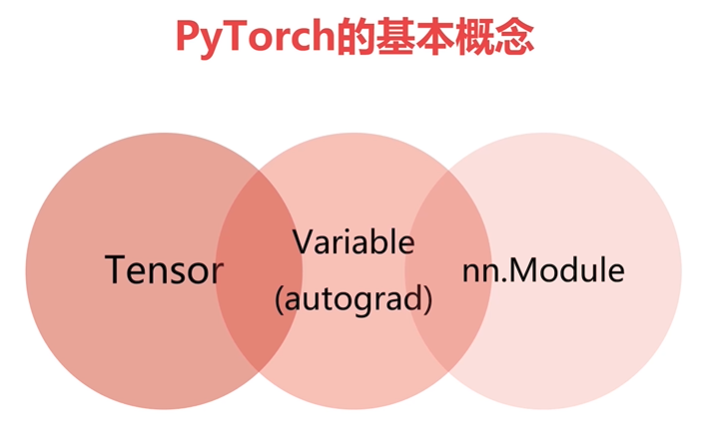
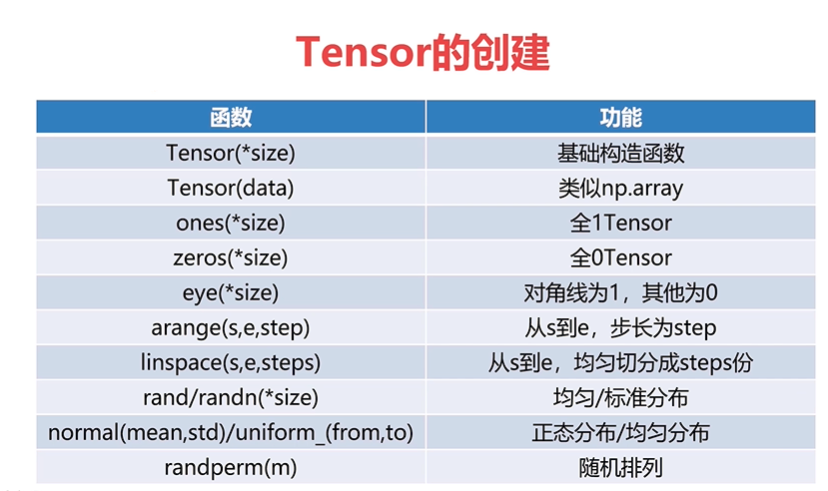

import torch
#定义向量
vector = torch.tensor([1,2,3,4])
print('Vector:\t\t', vector)
print('Vector Shape:\t', vector.shape)
Vector: tensor([1, 2, 3, 4])
Vector Shape: torch.Size([4])
#定义矩阵
matrix = torch.tensor([[1,2],[3,4]])
print('Matrix:\n', matrix)
print('Matirx Shape:\n', matrix.shape)
Matrix:
tensor([[1, 2],
[3, 4]])
Matirx Shape:
torch.Size([2, 2])
#定义张量
tensor = torch.tensor([[[1,2],[3,4]],[[1,2],[3,4]]])
print('Tensor:\n', tensor)
print('Tensor Shape:\n', tensor.shape)
Tensor:
tensor([[[1, 2],
[3, 4]],
[[1, 2],
[3, 4]]])
Tensor Shape:
torch.Size([2, 2, 2])
# torch.tensor( )是一个function,在pycharm使用的时候会有标志
# torch.Tensor是一个class,是torch.FloatTensor的别称
a = torch.Tensor([[1, 2],[3, 4]])
print(a)
print(a.type())# 直接定义是float类型
tensor([[1., 2.],
[3., 4.]])
torch.FloatTensor
b = torch.Tensor(2, 2) #直接使用shape定义tensor
print(b)
tensor([[1.0000e+00, 0.0000e+00],
[2.9848e-43, 0.0000e+00]])
d = torch.tensor(((1, 2), (3, 4)))
print(d.type())
print(d.type_as(a))
torch.LongTensor
tensor([[1., 2.],
[3., 4.]])
d = torch.empty(2,3)
print(d.type())
print(d.type_as(a))
torch.FloatTensor
tensor([[0., 0., 0.],
[0., 0., 0.]])
d = torch.zeros(2,3)
print(d.type())
print(d.type_as(a))
torch.FloatTensor
tensor([[0., 0., 0.],
[0., 0., 0.]])
d = torch.zeros_like(d)
print(d.type())
print(d.type_as(a))
torch.FloatTensor
tensor([[0., 0., 0.],
[0., 0., 0.]])
d = torch.eye(2, 2)
print(d.type())
print(d.type_as(a))
torch.FloatTensor
tensor([[1., 0.],
[0., 1.]])
d = torch.ones(2, 2)
print(d.type())
print(d.type_as(a))
d = torch.ones_like(d)
print(d.type())
print(d.type_as(a))
torch.FloatTensor
tensor([[1., 1.],
[1., 1.]])
torch.FloatTensor
tensor([[1., 1.],
[1., 1.]])
d = torch.rand(2, 3) # 随机浮点 [0, 1)
print(d.type())
print(d.type_as(a))
torch.FloatTensor
tensor([[0.9853, 0.5354, 0.3119],
[0.5001, 0.2459, 0.6053]])
d = torch.arange(2, 10, 2)
print(d.type())
print(d.type_as(a))
torch.LongTensor
tensor([2., 4., 6., 8.])
d = torch.linspace(10, 2, 3)
print(d.type())
print(d.type_as(a))
d
torch.FloatTensor
tensor([10., 6., 2.])
tensor([10., 6., 2.])
dd = torch.normal(mean=0, std=1, size=(2, 3))
dd
tensor([[ 1.9897, -1.0289, -0.4013],
[ 0.7787, -1.2150, -2.2234]])
d = torch.normal(mean=torch.rand(5), std=torch.rand(5))
# 五组 不同均值和标准差的数据 常用于初始化数据
print(d.type())
print(d.type_as(a))
torch.FloatTensor
tensor([0.8920, 0.2696, 1.0647, 1.3374, 0.8834])
d = torch.Tensor(2, 2).uniform_(-1, 1) #均匀分布
print(d.type())
print(d.type_as(a))
torch.FloatTensor
tensor([[-0.4591, -0.0127],
[-0.2035, -0.2403]])
d = torch.randperm(10) # 随机全排列
print(d.type())
print(d.type_as(a))
torch.LongTensor
tensor([9., 6., 3., 5., 0., 8., 4., 2., 1., 7.])
# 转换为numpy
d.numpy()
array([9, 6, 3, 5, 0, 8, 4, 2, 1, 7], dtype=int64)
Tensor的属性
d.dtype
torch.int64
d.device
device(type='cpu')
d.layout
# torch.layout 表明内存布局(memory layout),即 tensor 在物理设备中的储存结构。
#学过数据结构的都知道储存结构(物理结构)简单可以分为:顺序储存、链式储存。
# torch.layout 可选torch.stried或torch.sparse_coo。分别对应顺序储存、离散储存。
# 一般说,稠密张量适用torch.stried(跨步),稀疏张量(0 比较多)适用torch.sparse_coo。
torch.strided
dev = torch.device("cpu")
# dev = torch.device("cuda")
a = torch.tensor([2, 2],
dtype=torch.float32,
device=dev)
print(a)
i = torch.tensor([[0, 1, 2], [0, 1, 2]]) # 坐标 (0, 0) (1, 1) (2, 2)对角线
v = torch.tensor([1, 2, 3])
# 定义稀疏张量 coo 非零的元素的个数, 非零越多越稀疏
# (4, 4)是形状
a = torch.sparse_coo_tensor(i, v, (4, 4),
dtype=torch.float32,
device=dev)
print(a)
a.layout
tensor([2., 2.])
tensor(indices=tensor([[0, 1, 2],
[0, 1, 2]]),
values=tensor([1., 2., 3.]),
size=(4, 4), nnz=3, layout=torch.sparse_coo)
torch.sparse_coo
a = torch.sparse_coo_tensor(i, v, (4, 4),
dtype=torch.float32,
device=dev).to_dense() # 转换成稠密张量
print(a)
a.layout
tensor([[1., 0., 0., 0.],
[0., 2., 0., 0.],
[0., 0., 3., 0.],
[0., 0., 0., 0.]])
torch.strided
基本运算
##add
a = torch.arange(1, 7).reshape((2, 3))
b = torch.arange(1, 7).reshape((2, 3))
print(a)
print(b)
tensor([[1, 2, 3],
[4, 5, 6]])
tensor([[1, 2, 3],
[4, 5, 6]])
print(a + b)
print(a.add(b))
print(torch.add(a, b))
print(a)
print(a.add_(b))
print(a) # a的值会变
print(b)
tensor([[ 3, 6, 9],
[12, 15, 18]])
tensor([[ 3, 6, 9],
[12, 15, 18]])
tensor([[ 3, 6, 9],
[12, 15, 18]])
tensor([[ 2, 4, 6],
[ 8, 10, 12]])
tensor([[ 3, 6, 9],
[12, 15, 18]])
tensor([[ 3, 6, 9],
[12, 15, 18]])
tensor([[1, 2, 3],
[4, 5, 6]])
#sub
print("==== sub res ====")
print(a - b)
print(torch.sub(a, b))
print(a.sub(b))
print(a.sub_(b))
print(a)
==== sub res ====
tensor([[ 2, 4, 6],
[ 8, 10, 12]])
tensor([[ 2, 4, 6],
[ 8, 10, 12]])
tensor([[ 2, 4, 6],
[ 8, 10, 12]])
tensor([[ 2, 4, 6],
[ 8, 10, 12]])
tensor([[ 2, 4, 6],
[ 8, 10, 12]])

## mul
print("===== mul ====")
print(a * b) # 哈达玛积
print(torch.mul(a, b))
print(a.mul(b))
print(a)
print(a.mul_(b))
print(a)
===== mul ====
tensor([[ 2, 16, 54],
[128, 250, 432]])
tensor([[ 2, 16, 54],
[128, 250, 432]])
tensor([[ 2, 16, 54],
[128, 250, 432]])
tensor([[ 2, 8, 18],
[32, 50, 72]])
tensor([[ 2, 16, 54],
[128, 250, 432]])
tensor([[ 2, 16, 54],
[128, 250, 432]])
# div
a = torch.rand(2, 3)
b = torch.rand(2, 3)
print("=== div ===")
print(a/b)
print(torch.div(a, b))
print(a.div(b))
print(a.div_(b))
print(a)
=== div ===
tensor([[0.4915, 0.5121, 2.2019],
[1.7804, 0.4173, 1.5148]])
tensor([[0.4915, 0.5121, 2.2019],
[1.7804, 0.4173, 1.5148]])
tensor([[0.4915, 0.5121, 2.2019],
[1.7804, 0.4173, 1.5148]])
tensor([[0.4915, 0.5121, 2.2019],
[1.7804, 0.4173, 1.5148]])
tensor([[0.4915, 0.5121, 2.2019],
[1.7804, 0.4173, 1.5148]])
###matmul 矩阵相乘
a = torch.ones(2, 1)
b = torch.ones(1, 2)
print(a)
print(b)
## 以下都是一样的
print(a @ b)
print(a.matmul(b))
print(torch.matmul(a, b))
print(torch.mm(a, b))
print(a.mm(b))
tensor([[1.],
[1.]])
tensor([[1., 1.]])
tensor([[1., 1.],
[1., 1.]])
tensor([[1., 1.],
[1., 1.]])
tensor([[1., 1.],
[1., 1.]])
tensor([[1., 1.],
[1., 1.]])
tensor([[1., 1.],
[1., 1.]])
##高维tensor
a = torch.ones(1, 2, 3, 4)
b = torch.ones(1, 2, 4, 3)
print(a.matmul(b))
print(a.matmul(b).shape)
tensor([[[[4., 4., 4.],
[4., 4., 4.],
[4., 4., 4.]],
[[4., 4., 4.],
[4., 4., 4.],
[4., 4., 4.]]]])
torch.Size([1, 2, 3, 3])
##pow
a = torch.tensor([1, 2])
print(torch.pow(a, 3))
print(a.pow(3))
print(a**3)
print(a.pow_(3))
print(a)
tensor([1, 8])
tensor([1, 8])
tensor([1, 8])
tensor([1, 8])
tensor([1, 8])
#exp e的几次方
a = torch.tensor([1, 2],
dtype=torch.float32)
print(a.type())
print(torch.exp(a))
print(torch.exp_(a))
print(a.exp())
print(a.exp_())
torch.FloatTensor
tensor([2.7183, 7.3891])
tensor([2.7183, 7.3891])
tensor([ 15.1543, 1618.1781])
tensor([ 15.1543, 1618.1781])
##log
a = torch.tensor([10, 2],
dtype=torch.float32)
print(torch.log(a)) # 底数是e
print(torch.log2(a))
print(torch.log10(a))
print(torch.log_(a))
print(a.log())
print(a.log_())
tensor([2.3026, 0.6931])
tensor([3.3219, 1.0000])
tensor([1.0000, 0.3010])
tensor([2.3026, 0.6931])
tensor([ 0.8340, -0.3665])
tensor([ 0.8340, -0.3665])
##sqrt
a = torch.tensor([10, 2],
dtype=torch.float32)
print(torch.sqrt(a))
print(torch.sqrt_(a))
print(a.sqrt())
print(a.sqrt_())
tensor([3.1623, 1.4142])
tensor([3.1623, 1.4142])
tensor([1.7783, 1.1892])
tensor([1.7783, 1.1892])
a = torch.rand(2, 2)
a = a * 10
print(a)
print(torch.floor(a))
print(torch.ceil(a))
print(torch.round(a))
print(torch.trunc(a))
print(torch.frac(a))
print(a % 2)
b = torch.tensor([[2, 3], [4, 5]],
dtype=torch.float)
tensor([[6.3697, 7.0186],
[2.7078, 9.1732]])
tensor([[6., 7.],
[2., 9.]])
tensor([[ 7., 8.],
[ 3., 10.]])
tensor([[6., 7.],
[3., 9.]])
tensor([[6., 7.],
[2., 9.]])
tensor([[0.3697, 0.0186],
[0.7078, 0.1732]])
tensor([[0.3697, 1.0186],
[0.7078, 1.1732]])
a = torch.rand(2, 3)
b = torch.rand(2, 3)
print(a)
print(b)
print(torch.eq(a, b))
print(torch.equal(a, b))
print(torch.ge(a, b))
print(torch.gt(a, b))
print(torch.le(a, b))
print(torch.lt(a, b))
print(torch.ne(a, b))
tensor([[0.9355, 0.8971, 0.8710],
[0.9562, 0.6887, 0.5133]])
tensor([[0.5730, 0.4295, 0.9110],
[0.6943, 0.3907, 0.2165]])
tensor([[False, False, False],
[False, False, False]])
False
tensor([[ True, True, False],
[ True, True, True]])
tensor([[ True, True, False],
[ True, True, True]])
tensor([[False, False, True],
[False, False, False]])
tensor([[False, False, True],
[False, False, False]])
tensor([[True, True, True],
[True, True, True]])

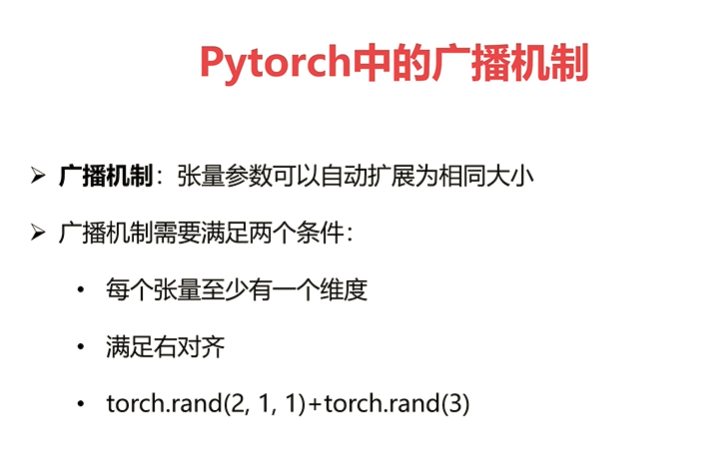 上面的rand(3)需要补充到 (1, 1, 3),从右面看满足右对齐的条件时 要么相等要么有一个是1
上面的rand(3)需要补充到 (1, 1, 3),从右面看满足右对齐的条件时 要么相等要么有一个是1
a = torch.tensor([[1, 4, 4, 3, 5],
[2, 3, 1, 3, 5]])
print(a.shape)
print(torch.sort(a, dim=1,
descending=False))
##topk
a = torch.tensor([[2, 4, 3, 1, 5],
[2, 3, 5, 1, 4]])
print(a.shape)
print(torch.topk(a, k=2, dim=1, largest=False))
print(torch.kthvalue(a, k=2, dim=0))
print(torch.kthvalue(a, k=2, dim=1))
a = torch.rand(2, 3)
print(a)
print(a/0)
print(torch.isfinite(a))
print(torch.isfinite(a/0))
print(torch.isinf(a/0))
print(torch.isnan(a))
import numpy as np
a = torch.tensor([1, 2, np.nan])
print(torch.isnan(a))
a = torch.rand(2, 3)
print(a)
print(torch.topk(a, k=2, dim=1, largest=False))
print(torch.topk(a, k=2, dim=1, largest=True))
a = torch.rand(2, 2)
b = torch.rand(1, 2)
d = torch.rand(1, 3)
# a, 2*1
# b, 1*2
# c, 2*2
# 2*4*2*3
c = a + b
print(a)
print(b)
print(c)
print(c.shape)
tensor([[0.9504, 0.3773],
[0.7862, 0.6375]])
tensor([[0.7592, 0.0868]])
tensor([[1.7096, 0.4641],
[1.5454, 0.7243]])
torch.Size([2, 2])
a + d
RuntimeError Traceback (most recent call last)
in ()
----> 1 a + d
RuntimeError: The size of tensor a (2) must match the size of tensor b (3) at non-singleton dimension 1
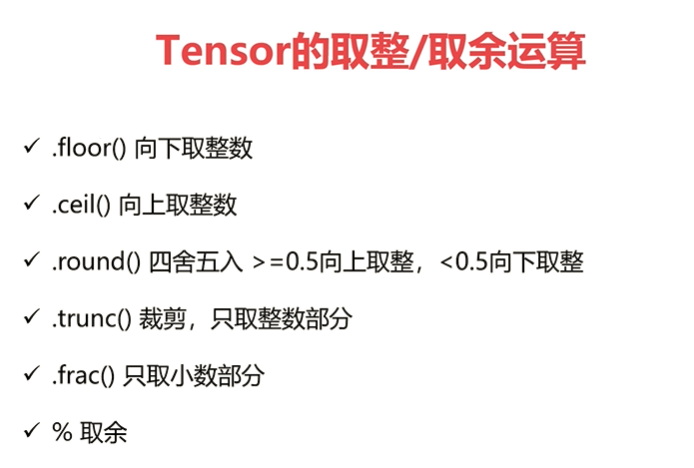
a = torch.rand(2, 2)
a = a * 10
print(a)
print(torch.floor(a))
print(torch.ceil(a))
print(torch.round(a))
print(torch.trunc(a))
print(torch.frac(a))
print(a % 2)
b = torch.tensor([[2, 3], [4, 5]],
dtype=torch.float)
tensor([[0.1020, 3.1624],
[5.8866, 3.4707]])
tensor([[0., 3.],
[5., 3.]])
tensor([[1., 4.],
[6., 4.]])
tensor([[0., 3.],
[6., 3.]])
tensor([[0., 3.],
[5., 3.]])
tensor([[0.1020, 0.1624],
[0.8866, 0.4707]])
tensor([[0.1020, 1.1624],
[1.8866, 1.4707]])
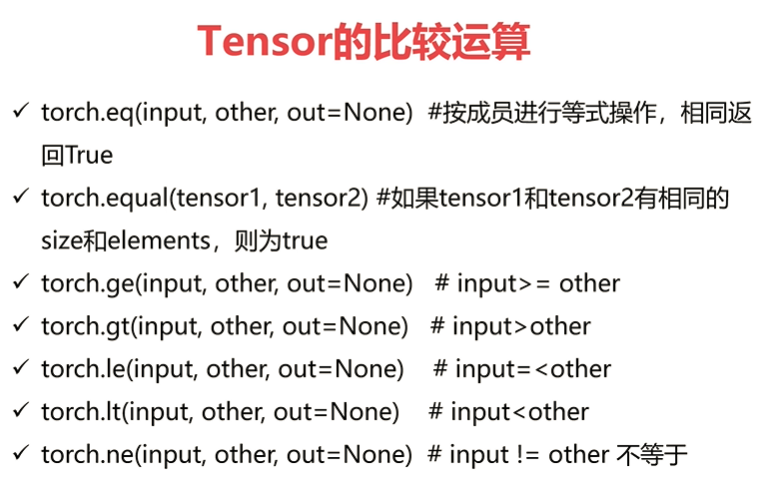























 1万+
1万+











 被折叠的 条评论
为什么被折叠?
被折叠的 条评论
为什么被折叠?








